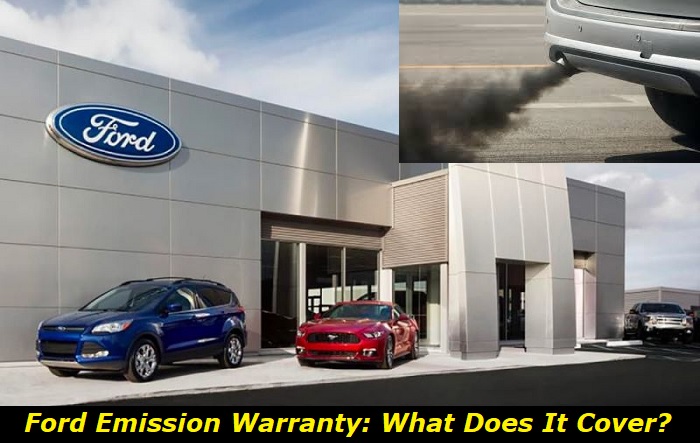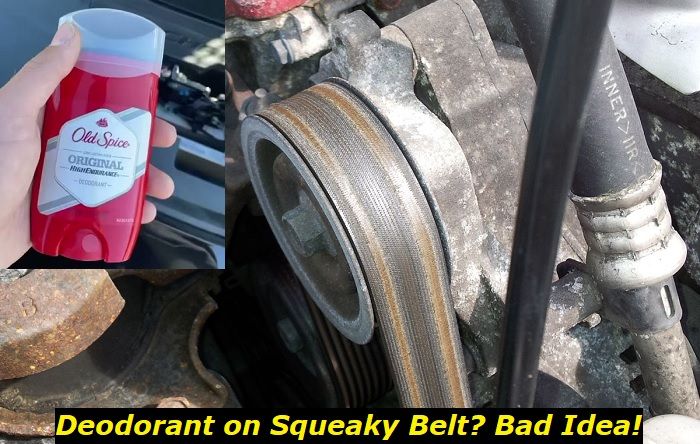Ford's Emissions Warranty aims to take care of customers' interest in keeping their vehicles in top shape while ensuring that they are compliant with emissions standards. This entitles owners of the brand's vehicles free repairs for any defects in its components subject to the automaker's conditions.

Terms and Duration in the Emissions Warranty of Ford
Ford provides free repairs for the faulty parts of its vehicles, especially those that influence emissions. However, this privilege is only extended to customers who are covered by the following terms:
- The vehicle was purchased from Ford and its official dealerships within the US and Canada.
- The auto should be maintained and operated in accordance with Ford's standards as stated in the vehicle manual.
- The regular scheduled maintenance of the product should be followed.
- The vehicle or its parts should not have been tampered with or abused in any way.
- Subject to the period or miles (whichever comes first) of coverage specified for certain parts.
- Applicable only to Ford vehicles up to 8,500 Gross Vehicle Weight Rating (GVWR).
Parts Covered by the Emissions Warranty of Ford
The following are the parts covered by the emissions warranty of Ford:
1. Air Flow Sensor
The airflow sensor in a Ford vehicle helps it to run properly. It measures the amount of air going into the engine and tells the car how much fuel it needs to mix with that air. This helps the engine work efficiently and stay clean.
2. Air/Fuel Feedback Control System and Sensors
This system serves as the first layer of detection ensuring that the right amount of air-fuel mixture is delivered to the engine.
3. Air Induction System
The air induction system in a Ford vehicle works hand in hand with the engine to help it run correctly. It further manages how much air is going into the engine and tells the car how much fuel should mix with that air.
4. Battery Energy Control Module (BECM)
The Battery Energy Control Module (BECM) ensures that the battery stays charged so that the electrical components of the auto get the right amount of energy when needed.
5. Catalytic Converter
The catalytic converter in a Ford vehicle helps the engine work more cleanly. It changes harmful gases into less harmful ones before they are released from the car. It works with other parts of the vehicle to ensure that the right amount of fuel and air mix together so that the engine runs correctly.
6. Electronic Engine Control Unit (ECU)
The Electronic Engine Control Unit (ECU) is an incredibly important part of a vehicle. It helps the engine operate efficiently and reliably by controlling the fuel injection, exhaust gas recirculation, ignition timing, and other aspects of engine performance.
The ECU's ability to adjust these functions helps ensure that the engine produces the most power with the least amount of fuel, leading to better fuel economy and lower emissions. Additionally, the ECU can detect potential problems with the engine and alert drivers before they become serious issues.
7. Electronic Engine Control Sensors and Switches
The ECU uses sensors and switches to determine and control various parameters such as temperature, airflow, pressure, and speed. It then sends this information to the onboard computer which processes it in order to adjust the settings accordingly. This helps make sure that all of these values stay within optimal ranges for optimal performance and maximum efficiency.
The ECU also works with other systems like traction control, anti-lock brakes, and stability control systems, among others, to help ensure that drivers have good control over their vehicles when driving conditions are less than ideal.
8. Evaporative Emission Control System
The Evaporative Emission Control System (EVAP) prevents fuel vapors from escaping into the atmosphere, reducing air pollution and making the air around us healthier. It works by trapping the fuel vapors in a canister before they can escape, then releasing them when the engine is running and combusting them along with the fuel.
9. Exhaust Gas Recirculation (EGR) System
The Exhaust Gas Recirculation (EGR) System recirculates the exhaust gases from the engine back into the intake manifold, thereby reducing the amount of nitrogen oxide produced during combustion. This helps reduce emissions and improve fuel economy.
The EGR system also allows for better control over engine temperature and performance, helping to keep engines running more efficiently and at lower temperatures than they would without it.
Additionally, this system can help reduce noise levels as well as wear and tear on other components due to its ability to cool down hot exhaust gases before they enter other parts of the vehicle's systems.
10. Exhaust Manifold
The exhaust manifold plays a crucial role in directing the hot exhaust gases from the cylinders out through the exhaust pipe. This allows for more efficient burning of fuel, resulting in lower emissions and better fuel economy.
In addition, it reduces noise levels by helping to muffle some of the sound produced by combustion. The manifold also helps reduce wear and tear on other components due to its ability to cool down hot exhaust gases before they enter other parts of the vehicle's systems. All these benefits help keep cars running smoother and longer with fewer issues over time.
11. Exhaust Pipe (Manifold to Catalyst)
The exhaust pipe from the manifold to the catalyst in a vehicle is an essential component of its engine, as it directs hot exhaust gases away from other sensitive components and out through the tailpipe. This helps reduce noise levels by muffling some of the sound produced by combustion and allows for more efficient burning of fuel, resulting in lower emissions and better fuel economy.
12. Fuel Filler Cap and Neck Restrictor
The fuel filler cap and neck restrictor are important components of a vehicle that help secure and keep the quality of the fuel in the reservoir. The cap seals the tank, preventing air and contaminants from entering, while the neck restrictor reduces the chance of filling the fuel tank with the incorrect fuel.
13. Fuel Injection System
The fuel injection system in a vehicle helps to provide the engine with an optimal mixture of fuel and air, which is necessary for efficient combustion. This system works by electronically controlling the amount of fuel and air being introduced into the cylinders, based on signals from various sensors in the engine.
14. Fuel Injector Supply Manifold
The fuel injector supply manifold in a vehicle plays an important role in providing the engine with an optimal mixture of fuel and air. It is responsible for directing the fuel from the fuel tank to the injectors, which then atomize and mix it with air before entering the engine.
This helps to ensure the engine gets a proper mixture of fuel and air for efficient combustion, resulting in better performance and lower emissions.
15. Fuel Tank
The fuel tank stores the fuel of the vehicle until it's needed or consumed by the engine. It also prevents the contamination of fuel with its sealing components.
16. High Voltage Battery
The high-voltage battery in a vehicle is an important component as it provides the power to start and run the engine as well as the electrical system of the vehicle. It also stores energy produced by the alternator when the engine is running.
17. Hybrid Battery Pack Sensor Module (HBPSM)
The Hybrid Battery Pack Sensor Module (HBPSM) is an important component of Ford hybrid vehicles, as it helps monitor the state and condition of the battery pack. This module is responsible for collecting and analyzing data such as voltage, temperature, and current, among others, to ensure the battery pack is functioning properly.
18. Idle Air Bypass Valve
The idle air bypass valve in a vehicle helps regulate the engine's idle speed by controlling the amount of air that is allowed to pass through the throttle body. This helps to ensure the engine runs smoothly at idle and prevents it from stalling or surging.
19. Ignition Coil and/or Control Module
The ignition coil and/or control module in a vehicle is responsible for providing the spark needed to ignite the fuel-air mixture in the engine.
20. Intake Manifold
The intake manifold in a vehicle is an integral part of its engine, as it helps to provide the engine with an optimal mixture of fuel and air. It is responsible for directing the air-fuel mixture from the throttle body into the cylinders of the engine, where it can be used for combustion.
21. Malfunction Indicator Lamp (MIL)/On-Board Diagnostic (OBD) System
The Malfunction Indicator Lamp (MIL) and On-Board Diagnostic (OBD) System are important components of a vehicle that help identify and diagnose potential issues within its engine and various systems.
22. PCV System and Oil Filler Cap
The PCV system and oil filler cap are essential components of a vehicle, as they help keep the engine clean and running efficiently. The PCV system helps to reduce the amount of contaminants in the engine by letting unburned fuel and exhaust gases escape, while the oil filler cap seals off the engine, preventing contaminants from entering.
23. Secondary Air Injection System
The Secondary Air Injection System (SAIS) aids in reducing emissions from the vehicle by injecting fresh air into the exhaust system. This fresh air helps to further burn the unburned fuel and exhaust gases, resulting in lower emissions.
24. Spark Control Components
The spark control components in a vehicle are responsible for controlling the timing and intensity of the spark produced by the ignition system. This ensures that the engine runs efficiently with the correct timing and amount of spark, resulting in improved performance and lower emissions.
25. Spark Plugs and Ignition Wires
The spark plugs and ignition wires are essential components of a vehicle, as they help create the spark needed for combustion. The spark plug produces sparks at the correct time and intensity, while the ignition wires help to carry this spark from the coil to the cylinders of the engine.
26. Synchronizer Assembly
The synchronizer assembly helps to ensure that the crankshaft and camshaft in an engine are rotating at the proper speed and timing.
27. Thermostat
The thermostat and coolant system are essential components of a vehicle, as they help to regulate the temperature within the engine to prevent overheating.
28. Throttle Body Assembly (MFI)
The throttle body assembly (MFI) regulates the amount of air that enters the engine, by controlling the opening and closing of the butterfly valve within the throttle body. This helps to ensure the engine is receiving the correct amount of air for optimal performance and fuel efficiency.
29. Vacuum Distribution System
The vacuum distribution system mainly helps control the engine rotations per minute (RPM) while idle.
Conclusion
Understanding the coverage of the Ford emissions warranty is essential for any Ford owner. It is important for you to know its coverage and the perfect timing to use it in order to get the most out of your purchase and ensure that the right repairs are made to your investment if needed.
About the authors
The CarAraC research team is composed of seasoned auto mechanics and automotive industry professionals, including individuals with advanced degrees and certifications in their field. Our team members boast prestigious credentials, reflecting their extensive knowledge and skills. These qualifications include: IMI: Institute of the Motor Industry, ASE-Certified Master Automobile Technicians; Coventry University, Graduate of MA in Automotive Journalism; Politecnico di Torino, Italy, MS Automotive Engineering; Ss. Cyril and Methodius University in Skopje, Mechanical University in Skopje; TOC Automotive College; DHA Suffa University, Department of Mechanical Engineering






Add comment